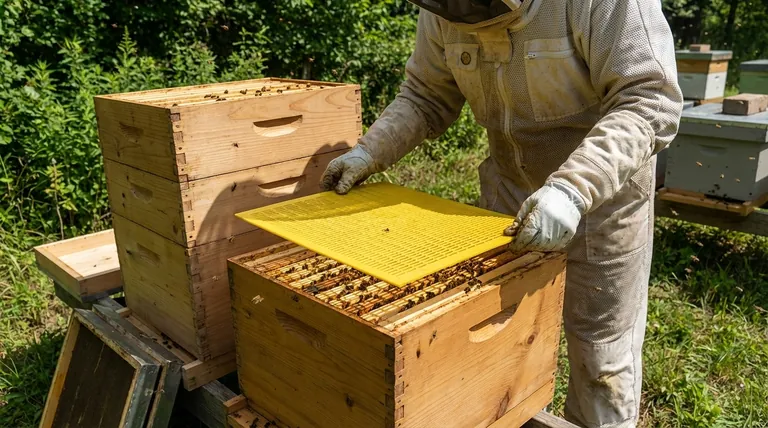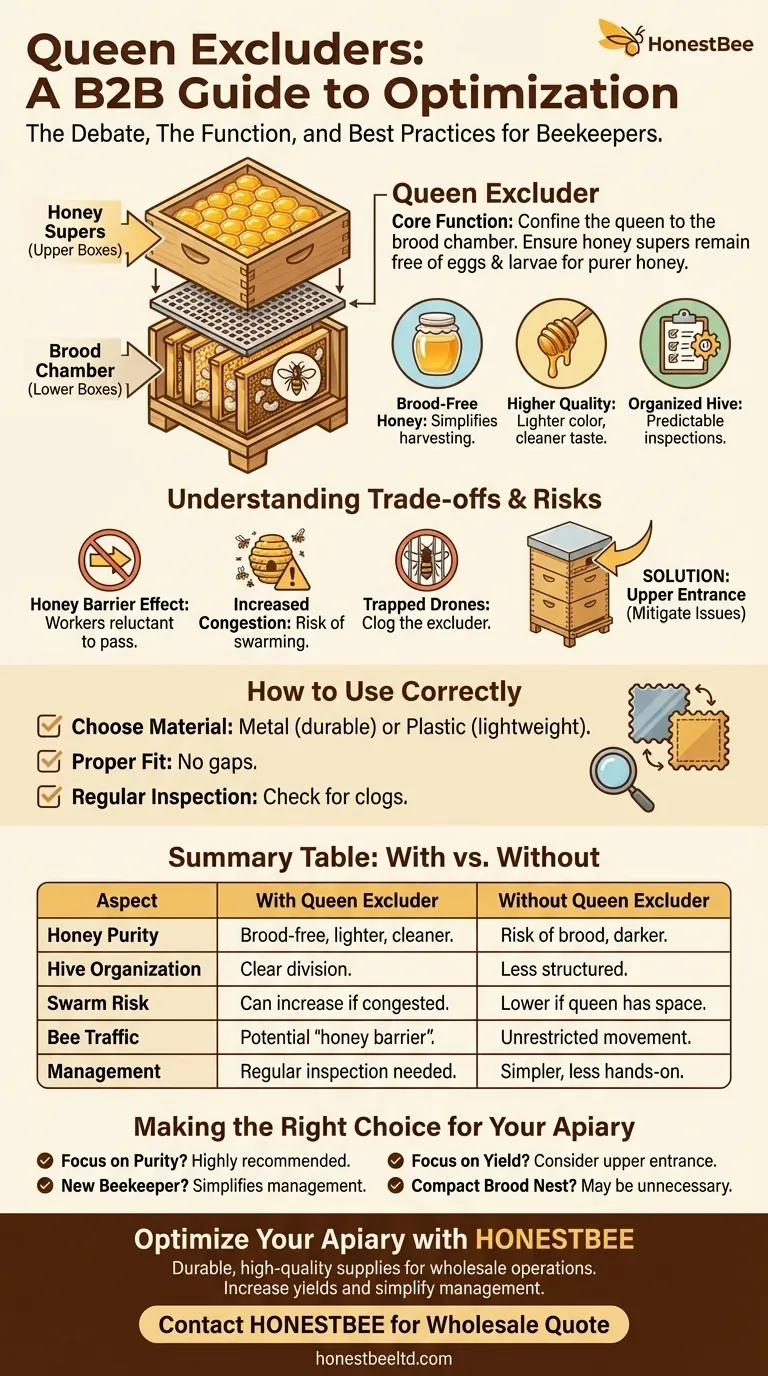The queen excluder is one of the most debated tools in beekeeping. The general recommendation is to experiment with using one in your hives. Its primary purpose is to confine the queen to the brood chamber, ensuring that honey supers remain free of eggs and larvae. This leads to cleaner, purer honey and simplifies harvesting, but its effectiveness is highly dependent on proper management.
The core question isn't whether queen excluders are "good" or "bad," but rather when and how they should be used. An excluder is a powerful tool for hive organization, but it introduces trade-offs that can impact colony productivity and behavior if not managed correctly.

The Core Function: Why Use a Queen Excluder?
A queen excluder is a perforated barrier placed between the brood boxes and the honey supers. The holes are large enough for worker bees to pass through but too small for the larger queen and drones.
Ensuring Brood-Free Honey Supers
The primary benefit is preventing the queen from laying eggs in the honey supers. This dedicates that space purely to the storage and curing of honey.
When honey is extracted, you can be certain you are not also destroying eggs or larvae, which simplifies the entire harvesting process.
The Impact on Honey Quality
Honey harvested from frames that have never contained brood is considered the purest and often has a lighter color and cleaner taste.
Frames used for brood rearing accumulate "postnatal cocoons," which are remnants of pupation, debris, and bee feces that can darken the wax and potentially affect the honey.
Organizing the Hive Structure
Using an excluder creates a clear division of labor within the hive. The lower boxes are for raising new bees (the brood nest), and the upper boxes are for storing winter food (the honey supers).
This organization makes hive inspections more predictable, as you know exactly where to look for the queen and assess the health of the brood.
Understanding the Trade-offs and Risks
While beneficial, excluders are not a "set it and forget it" tool. They fundamentally alter the bees' movement and can create new management challenges.
The "Honey Barrier" Effect
Some beekeepers observe that worker bees can be reluctant to pass through the excluder. This can sometimes lead to a "honey barrier," where bees store nectar in the brood chamber instead of moving it up into the supers.
This can reduce the overall honey yield if the colony isn't strong enough or motivated to work through the barrier.
Increased Brood Box Congestion
By confining the queen, you risk creating intense congestion in the brood chamber. If the queen runs out of space to lay, and workers backfill empty cells with nectar, the colony can quickly become "honey bound."
A congested brood nest is a primary trigger for swarming. Therefore, an improperly managed excluder can actually increase swarm risk rather than prevent it.
The Problem with Drones
Drones (male bees) are too large to pass through the excluder. If they hatch in the honey supers (from an unfertilized egg laid before the excluder was placed), they will be trapped.
More commonly, drones in the brood box cannot move up into the supers. They can sometimes clog the excluder as they try to pass through, impeding worker bee traffic.
The Upper Entrance Solution
A common technique to mitigate these issues is to provide a small upper entrance for the hive, located above the queen excluder.
This gives foraging bees a direct path into the honey supers, reducing traffic through the excluder and minimizing wear and tear on their wings. It also gives drones an alternative exit.
How to Use an Excluder Correctly
Success with a queen excluder comes down to proper application and observation.
Choosing Your Material
Excluders are typically made of metal or plastic. Metal is more durable and rigid but also heavier, more expensive, and can chill bees in cold weather. Plastic is lightweight and cheaper but can be less durable and may warp over time.
Proper Installation and Fit
The excluder must fit squarely on top of the brood box, leaving no gaps around the edges. A determined queen can squeeze through very small openings, defeating the entire purpose of the tool.
Regular Inspection
Periodically check the excluder to ensure it is not clogged with pollen, propolis, or dead drones. Blockages will prevent workers from reaching the honey supers.
Monitor the hive to confirm the queen is successfully confined and that workers are actively moving into the supers to store honey.
Making the Right Choice for Your Apiary
The decision to use a queen excluder depends on your beekeeping philosophy and specific goals.
- If your primary focus is maximum honey purity for sale or competition: An excluder is highly recommended to guarantee brood-free frames.
- If your primary focus is maximizing honey yield in a very strong colony: Consider providing an upper entrance above the excluder to facilitate easy access to the supers.
- If you are a new beekeeper seeking organization: An excluder can simplify hive management by creating a clear distinction between the brood nest and honey stores.
- If your colony has a queen that naturally keeps a compact brood nest: You may find an excluder is unnecessary, as the queen will stay below on her own.
Ultimately, the best approach is to observe your specific colonies and use the queen excluder as a deliberate tool, not as a default requirement.
Summary Table:
| Aspect | With Queen Excluder | Without Queen Excluder |
|---|---|---|
| Honey Purity | Brood-free supers, lighter, cleaner honey | Risk of brood in supers, darker honey |
| Hive Organization | Clear division: brood chamber vs. honey supers | Less structured, queen can lay anywhere |
| Swarm Risk | Can increase if brood chamber becomes honey-bound | Lower if queen has space to expand brood nest |
| Bee Traffic | Potential 'honey barrier'; workers may be reluctant | Unrestricted movement for all bees |
| Management | Requires regular inspection for blockages | Simpler, less hands-on management |
Ready to Optimize Your Apiary with the Right Equipment?
Whether you're a commercial apiary focused on honey purity or a distributor supplying beekeepers, the right tools are crucial for success. HONESTBEE supplies durable, high-quality beekeeping supplies and equipment, including queen excluders, designed for the demands of wholesale operations.
Let us help you increase yields and simplify hive management. Contact HONESTBEE today to discuss your equipment needs and get a quote!
Visual Guide

Related Products
- Professional Plastic Queen Excluder for Modern Beekeeping
- Wooden Queen Bee Excluder for Beekeeping
- Premium Wood Framed Metal Wire Queen Bee Excluder
- Metal Queen Bee Excluder for Beekeeping
- High Performance Plastic Queen Excluder for Beekeeping and Apiary Management
People Also Ask
- How do queen excluders work in terms of spacing and bee movement? A Guide to Precision Hive Management
- Why are queen excluders recommended for Flow Hives? Prevent Brood Damage for a Clean Harvest
- What are the pros of using queen excluders? Boost Honey Production & Hive Efficiency
- How does a queen excluder work? Master Hive Management for Pure Honey Harvests
- What are the main advantages of using a queen excluder in beekeeping? Simplify Hive Management & Harvest



















